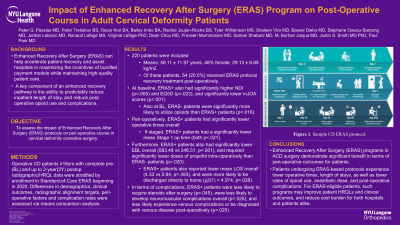Impact of Enhanced Recovery After Surgery (ERAS) Program on Post-Operative Course in Adult Cervical Deformity Patients
Impact of Enhanced Recovery After Surgery (ERAS) Program on Post-operative Course in Adult Cervical Deformity Patients
Friday, April 21, 2023


Jamshaid M. Mir, MD
Research Fellow
NYU Langone Medical Center
Paterson, NJ, US
ePoster Presenter(s)
Introduction: Enhanced Recovery After Surgery (ERAS) can help accelerate patient recovery and assist hospitals in maximizing the incentives of bundled payment models while maintaining high-quality patient care. A key component of an enhanced recovery pathway is the ability to predictably reduce inpatient length of stay and reduce post-operative opioid use and complications.
Methods: Operative CD patients ≥18yrs with pre-(BL) and 2-year(2Y) radiographic/HRQL data were stratified by enrollment in ERAS beginning in 2020. Differences in demographics, clinical outcomes, radiographic alignment targets, peri-operative factors and complication rates were assessed via means comparison analysis.
Results: 220 patients were included (58.11 ± 11.97 years, 48% female, 29.13 ± 6.89 kg/m2. Of these patients, 54 (20.0%) received ERAS protocol recovery treatment post-operatively. At baseline, ERAS+ also had significantly higher NDI (p=.005) and EQ5D (p=.023), and significantly lower mJOA scores (p < .001). At BL, ERAS- patients were significantly more likely to utilize opioids than ERAS+ patients (p=.016). Peri-operatively, ERAS+ patients had significantly lower operative times overall, and if staged, ERAS+ patients had a significantly lower mean Stage 1 op time (both p < .021). Furthermore, ERAS+ patients also had significantly lower EBL overall (583.48 vs 246.51, p < .001), and required significantly lower doses of propofol intra-operatively than ERAS- patients (p=.020). ERAS+ patients also reported lower mean LOS overall (4.33 vs 5.84, p=.393), and were more likely to be discharged directly to home (χ2(1) = 4.974, p=.028). ERAS+ patients were less likely to require steroids after surgery (p=.045), were less likely to develop neuromuscular complications overall (p=.025), and less likely experience venous complications or be diagnosed with venous disease post-operatively (p=.025).
Conclusion : Enhanced Recovery After Surgery (ERAS) programs in ACD surgery demonstrate significant benefit in terms of peri-operative outcomes for patients. Patients undergoing ERAS-based protocols experience lower operative times, length of stays, as well as lower rates of opioid use, anesthetic dose, and post-operative complications.
Methods: Operative CD patients ≥18yrs with pre-(BL) and 2-year(2Y) radiographic/HRQL data were stratified by enrollment in ERAS beginning in 2020. Differences in demographics, clinical outcomes, radiographic alignment targets, peri-operative factors and complication rates were assessed via means comparison analysis.
Results: 220 patients were included (58.11 ± 11.97 years, 48% female, 29.13 ± 6.89 kg/m2. Of these patients, 54 (20.0%) received ERAS protocol recovery treatment post-operatively. At baseline, ERAS+ also had significantly higher NDI (p=.005) and EQ5D (p=.023), and significantly lower mJOA scores (p < .001). At BL, ERAS- patients were significantly more likely to utilize opioids than ERAS+ patients (p=.016). Peri-operatively, ERAS+ patients had significantly lower operative times overall, and if staged, ERAS+ patients had a significantly lower mean Stage 1 op time (both p < .021). Furthermore, ERAS+ patients also had significantly lower EBL overall (583.48 vs 246.51, p < .001), and required significantly lower doses of propofol intra-operatively than ERAS- patients (p=.020). ERAS+ patients also reported lower mean LOS overall (4.33 vs 5.84, p=.393), and were more likely to be discharged directly to home (χ2(1) = 4.974, p=.028). ERAS+ patients were less likely to require steroids after surgery (p=.045), were less likely to develop neuromuscular complications overall (p=.025), and less likely experience venous complications or be diagnosed with venous disease post-operatively (p=.025).
Conclusion : Enhanced Recovery After Surgery (ERAS) programs in ACD surgery demonstrate significant benefit in terms of peri-operative outcomes for patients. Patients undergoing ERAS-based protocols experience lower operative times, length of stays, as well as lower rates of opioid use, anesthetic dose, and post-operative complications.
